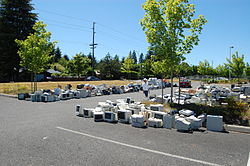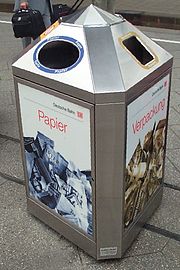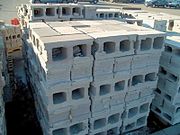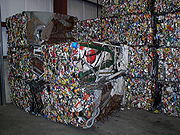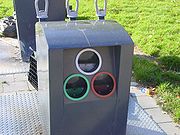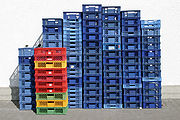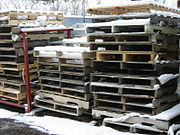
Recycling
About this schools Wikipedia selection
This content from Wikipedia has been selected by SOS Children for suitability in schools around the world. A good way to help other children is by sponsoring a child
Recycling involves processing used materials into new products in order to prevent the waste of potentially useful materials, reduce the consumption of fresh raw materials, reduce energy usage, reduce air (from incineration) and water (from landfilling) pollution by reducing the need for "conventional" waste disposal, and lower greenhouse gas emissions as compared to virgin production. Recycling is a key component of modern waste management and is the third component of the " Reduce, Reuse, Recycle" waste hierarchy.
Recyclable materials include glass, paper, metal, textiles and plastics. Though similar, the composting of biodegradable waste – such as food or garden waste – is not typically considered recycling. These materials are either brought to a collection centre or picked-up from the curbside; and sorted, cleaned and reprocessed into new products bound for manufacturing.
Background
In the US, recycling facilities currently generate estimated revenues of $2,981 million a year. Growth has exceeded 7 percent per year for the past five years (from 2003 to 2008) due to rising waste volumes and increasing recyclable commodity prices. New initiatives can change the industry. For example in California, and New York moves to raise the requirements for the set amount of waste to be diverted from the waste stream from 50 percent to 75 percent can produce healthy profits for companies that collect and process recyclables.
Cost-benefit analysis
There is some debate over whether recycling is economically efficient. Municipalities often see fiscal benefits from implementing recycling programs, largely due to the reduced landfill costs. A study conducted by the Technical University of Denmark found that in 83% of cases, recycling is the most efficient method to dispose of household waste. In addition to fiscal benefits, justification for recycling lie in what economists call externalities, unpriced costs and benefits which accrue to individuals outside of private transactions. Examples include increased air pollution and greenhouse gases from incineration, reduced hazardous waste leaching from landfills, reduced energy consumption, and reduced waste and resource consumption, which leads to a reduction in environmentally damaging mining and timber activity. Without mechanisms such as taxes or subsidies to internalize externalities, businesses will ignore them despite the costs imposed on society. In order to make such non-fiscal benefits economically relevant, advocates have pushed for legislative action to increase the demand for recycled materials. The United States Environmental Protection Agency (EPA) has concluded in favour of recycling, saying that recycling efforts reduced the country's carbon emissions by a net 49 million metric tonnes in 2005. In the United Kingdom, the Waste and Resources Action Programme stated that Great Britain's recycling efforts reduce CO2 emissions by 10-15 tonnes a year. Recycling is more efficient in densely populated areas, as there are economies of scale involved.
Certain requirements must be met in order for recycling to be economically feasible and environmentally effective. These include an adequate source of recyclates, a system to extract those recyclates from the waste stream, a nearby factory capable of reprocessing the recyclates, and a potential demand for the recycled products. These last two requirements are often overlooked—without both an industrial market for production using the collected materials and a consumer market for the manufactured goods, recycling is incomplete and in fact only "collection".
| Material | Energy Savings | Air Pollution Savings |
|---|---|---|
| Aluminium | 95% | 95% |
| Cardboard | 24% | — |
| Glass | 5-30% | 20% |
| Paper | 40% | 73% |
| Plastics | 70% | — |
| Steel | 60% | — |
Trade in recyclates
Certain countries trade in unprocessed recyclates. Some have complained that the ultimate fate of recyclates sold to another country is unknown and they may end up in landfill instead of reprocessed. According to one report, in America, 50-80% of computers destined for recycling are actually not recycled. However, Pieter van Beukering, an economist specialising in waste imports of China and India, believes that it is unlikely that bought materials would merely be dumped in landfill: he also claims that the import of recyclates allows for large-scale reprocessing, improving both the fiscal and environmental return through economies of scale. There are reports of illegal-waste imports to China being dismantled and recycled solely for monetary gain, without consideration for workers' health or environmental damage. Though the Chinese government has banned these practices, it has not been able to eradicate them completely, nor estimate the amount of illegal recycling still occurring.
Certain regions have difficulty using or exporting as much of a material as they recycle. This problem is most prevalent with glass: both Britain and the US import large quantities of wine bottled in green glass. Though much of this glass is sent to be recycled, outside the American Midwest there is not enough wine production to use all of the reprocessed material. The extra must be downcycled into building materials or re-inserted into the regular waste stream.
Similarly, the northwestern United States has difficultly finding markets for recycled newspaper, given the large number of pulp mills in the region as well as the proximity to Asian markets. In other areas of the US, however, demand for used newsprint has seen wide fluctuation.
Legislation
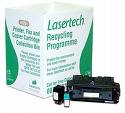
Supply
In order for a recycling program to work, having a large, stable supply of recyclable material is crucial. Three legislative options have been used to create such a supply: mandatory recycling collection, container deposit legislation, and refuse bans. Mandatory collection laws set recycling targets for cities to aim for, usually in the form that a certain percentage of a material must be diverted from the city's waste stream by a target date. The city is then responsible for working to meet this target.
Container deposit legislation involves offering a refund for the return of certain containers, typically glass, plastic, and metal. When a product in such a container is purchased, a small surcharge is added to the price. This surcharge can be reclaimed by the consumer if the container is returned to a collection point. These programs have been very successful, often resulting in an 80% recycling rate. Despite such good results, the shift in collection costs from local government to industry and consumers has created strong opposition to the creation of such programs in some areas.
A third method of increase supply of recyclates is to ban the disposal of certain materials as waste, often including used oil, old batteries, tires and garden waste. One aim of this method is to create a viable economy for proper disposal of banned products. Care must be taken that enough of these recycling services exist, or such bans simply lead to increased illegal dumping.
Government-mandated demand
Legislation has also been used to increase and maintain a "demand" for recycled materials. Four methods of such legislation exist: minimum recycled content mandates, utilisation rates, procurement policies, recycled product labelling.
Both minimum recycled content mandates and utilisation rates increase "demand" directly by forcing manufacturers to include recycling in their operations. Content mandates specify that a certain percentage of a new product must consist of recycled material. Utilisation rates are a more flexible option: industries are permitted to meet the recycling targets at any point of their operation or even contract recycling out in exchange for tradeable credits. Opponents to both of these methods point to the large increase in reporting requirements they impose, and claim that they rob industry of necessary flexibility.
Governments have used their own purchasing power to increase recycling demand through what are called "procurement policies". These policies are either "set-asides", which earmark a certain amount of spending solely towards recycled products, or "price preference" programs which provide a larger budget when recycled items are purchased. Additional regulations can target specific cases: in the US, for example, the Environmental Protection Agency mandates the purchase of oil, paper, tires and building insulation from recycled or re-refined sources whenever possible.
The final government regulation towards increased demand is recycled product labeling. When producers are required to label their packaging with amount of recycled material in the product (including the packaging), consumers are better able to make educated choices. Consumers with sufficient buying power can then choose more environmentally conscious options, prompt producers to increase the amount of recycled material in their products, and indirectly increase demand. Standardised recycling labelling can also have a positive affect on supply of recyclates if the labelling includes information on how and where the product can be recycled.
Process
Collection
A number of different systems have been implemented to collect recyclates from the general waste stream. These systems tend to lie along the spectrum of trade-off between public convenience and government ease and expense. The three main categories of collection are "drop-off centres", "buy-back centres" and "curbside collection".
Drop-off centres require the waste producer carry the recyclates to a central location, either a installed or mobile collection station or the reprocessing plant itself. They are the easiest type of collection to establish, but suffer from low and unpredictable throughput. Buy-back centres differ in that the cleaned recyclates are purchased, thus providing an clear incentive for use and creating a stable supply. The post-processed material can then be sold on, hopefully creating a profit. Unfortunately government subsidies are necessary to make buy-back centres a viable enterprise, as according to the United States Nation Solid Wastes Management Association it costs on average US$50 to process a ton of material, which can only be resold for US$30.
Curbside collection
Curbside collection encompasses many subtly different systems, which differ mostly on where in the process the recyclates are sorted and cleaned. The main categories are "mixed waste collection", "commingled recyclables" and "source separation". A waste collection vehicle generally picks up the waste.
At one end of the spectrum is "mixed waste collection", in which all recyclates are collected mixed in with the rest of the waste, and the desired material is then sorted out and cleaned at a central sorting facility. This results in a large amount of recyclable waste, paper especially, being too soiled to reprocess, but has advantages as well: the city need not pay for a separate collection of recyclates and no public education is needed. Any changes to which materials are recyclable is easy to accommodate as all sorting happens in a central location.
In a "Commingled" or "single-stream" system, all recyclables for collection are mixed but kept separate from other waste. This greatly reduces the need for post-collection cleaning but does require public education on what materials are recyclable.
"Source separation" is the other extreme, where each material is cleaned and sorted prior to collection. This method requires the least post-collection sorting and produces the purest recyclates, but incurs additional operating costs for collection of each separate material. An extensive public education program is also required, which must be successful if recyclate contamination is to be avoided.
Source separation used to be the preferred method due to the high sorting costs incurred by commingled collection. Advances in sorting technology (see "sorting" below), however, have lowered this overhead substantially—many areas which had developed source separation programs have since switched to comingled collection.
Sorting
Once commingled recyclates are collected and delivered to a central collection facility, the different types of materials must be sorted. This is done in a series of stages, many of which involve automated processes such that a truck-load of material can be fully sorted in less than an hour.
Initially, the commingled recyclates are removed from the collection vehicle and placed on a conveyor belt spread out in a single layer. Large pieces of cardboard and plastic bags are removed by hand at this stage, as they can cause later machinery to jam.
Next, automated machinery separates the recyclates by weight, splitting lighter paper and plastic from heavier glass and metal. Cardboard is removed from the mixed paper and the most common types of plastic ( PET and HDPE) are collected. This separation is usually done by hand, but has become automated in some sorting centres: a spectroscopic scanner is used to differentiate between different types of paper and plastic based on the absorbed wavelengths, and subsequently divert each material into the proper collection channel.
Strong magnets are used to separate out ferrous metals (tin-plated or steel cans), while non-ferrous metals are ejected by magnetic eddy currents. A rotating magnetic field induces an electric current around the aluminium cans, which in turn creates a magnetic eddy current inside the cans. This magnetic eddy current is repulsed by the large magnetic field, and the cans are ejected from the rest of the recyclate stream.
Finally, glass must be sorted by hand based on its colour: brown, amber, green or clear.
Common recyclables
Many different materials can be recycled but each type requires a different technique.
Aggregates and concrete
Concrete aggregate collected from demolition sites is put through a crushing machine, often along with asphalt, bricks, dirt, and rocks. Smaller pieces of concrete are used as gravel for new construction projects. Crushed recycled concrete can also be used as the dry aggregate for brand new concrete if it is free of contaminants. This reduces the need for other rocks to be dug up, which in turn saves trees and habitats.
Batteries
The large variation in size and type of batteries makes their recycling extremely difficult: they must first be sorted into similar kinds and each kind requires an individual recycling process. Additionally, older batteries contain mercury and cadmium, harmful materials which must be handled with care. Because of their potential environmental damage, proper disposal of used batteries is required by law in many areas. Unfortunately, this mandate has been difficult to enforce.
Lead-acid batteries, like those used in automobiles, are relatively easy to recycle and many regions have legislation requiring vendors to accept used products. In the United States, the recycling rate is 90%, with new batteries containing up to 80% recycled material.
Biodegradable waste
Kitchen, garden and other green waste can be recycled into useful material by composting. This process allows natural aerobic bacteria to break down the waste into fertile topsoil. Much composting is done on a household scale, but municipal green-waste collection programs also exist. These programs can supplement their funding by selling the topsoil produced.
Clothing
Recycling clothes via consignment or swapping has become increasingly popular. In a clothing swap, a group of people gather at a venue to exchange clothes amongst each other. In organizations like Clothing Swap, Inc., unclaimed clothing is donated to a local charity.
Electronics disassembly and reclamation
The direct disposal of electrical equipment—such as old computers and mobile phones—is banned in many areas due to the toxic contents of certain components. The recycling process works by mechanically separating the metals, plastics and circuit boards contained in the appliance. When this is done on a large scale at an electronic waste recycling plant, component recovery can be achieved in a cost-effective manner.
Ferrous metals
Iron and steel are the world's most recycled materials, and among the easiest materials to reprocess, as they can be separated magnetically from the waste stream. Recycling is via a steelworks: scrap is either remelted in an Electric Arc Furnace (90-100% scrap), or used as part of the charge in a Basic Oxygen Furnace (around 25% scrap). Any grade of steel can be recycled to top quality new metal, with no 'downgrading' from prime to lower quality materials as steel is recycled repeatedly. 42% of crude steel produced is recycled material.
Non-ferrous metals
Aluminium is one of the most efficient and widely-recycled materials. Aluminium is shredded and ground into small pieces or crushed into bales. These pieces or bales are melted in an aluminium smelter to produce molten aluminium. By this stage the recycled aluminium is indistinguishable from virgin aluminium and further processing is identical for both. This process does not produce any change in the metal, so aluminium can be recycled indefinitely.
Recycling aluminium saves 95% of the energy cost of processing new aluminium. This is because the temperature necessary for melting recycled, nearly pure, aluminium is 600 °C, while to extract mined aluminium from its ore requires 900 °C. To reach this higher temperature, much more energy is needed, leading to the high environmental benefits of aluminium recycling.
Glass
Glass bottles and jars are gathered via curbside collection schemes and bottle banks, where the glass may be sorted into colour categories. The collected glass cullet is taken to a glass recycling plant where it is monitored for purity and contaminants are removed. The cullet is crushed and added to a raw material mix in a melting furnace. It is then mechanically blown or molded into new jars or bottles. Glass cullet is also used in the construction industry for aggregate and glassphalt. Glassphalt is a road-laying material which comprises around 30% recycled glass. Glass can be recycled indefinitely as its structure does not deteriorate when reprocessed.
Paper
Paper can be recycled by reducing it to pulp and combing it with pulp from newly harvested wood. As the recycling process causes the paper fibres to breakdown, each time paper is recycled its quality decreases. This means that either a higher percentage of new fibres must be added, or the paper downcycled into lower quality products. Any writing or colouration of the paper must first be removed by deinking, which also removes fillers, clays, and fibre fragments.
Almost all paper can be recycled today, but some types are harder to recycle than others. Papers coated with plastic or aluminium foil, and papers that are waxed, pasted, or gummed are usually not recycled because the process is too expensive. Gift wrap paper also cannot be recycled due to its already poor quality.
Sometimes recyclers ask for the removal of the glossy inserts from newspapers because they are a different type of paper. Glossy inserts have a heavy clay coating that some paper mills cannot accept. Most of the clay is removed from the recycled pulp as sludge which must be disposed of. If the coated paper is 20% by weight clay, then each ton of glossy paper produces more than 200 kg of sludge and less than 800 kg of fibre.
Plastic
Plastic recycling is the process of recovering scrap or waste plastics and reprocessing the material into useful products. Compared to glass or metallic materials, plastic poses unique challenges. Because of the massive number of types of plastic, they each carry a resin identification code, and must be sorted before they can be recycled. This can be costly; while metals can be sorted using electromagnets, no such 'easy sorting' capability exists for plastics. In addition to this, while labels do not need to be removed from bottles for recycling, lids are often made from a different kind of non-recyclable plastic.
Textiles
When considering textile recycling one must understand what the material consists of. Most textiles are composites of cotton (biodegradable material) and synthetic plastics. The textile's composition will affect its durability and method of recycling.
Workers sort and separate collected textiles into good quality clothing and shoes which can be reused or worn. There is a trend of moving these facilities from developed countries to developing countries either for charity or sold at a cheaper price. Many international organisations collect used textiles from developed countries as a donation to those third world countries. This recycling practise is encouraged because it helps to reduce unwanted waste while providing clothings to the needies. Damaged textiles are further sorted into grades to make industrial wiping cloths and for use in paper manufacture or material suitable for fibre reclamation and filling products. If textile reprocessors receive wet or soiled clothes however, these may still be disposed of in a landfill, as the washing and drying facilities are not present at sorting units.
Fibre reclamation mills sort textiles according to fibre type and colour. Colour sorting eliminates the need to re-dye the recycled textiles. The textiles are shredded into "shoddy" fibres and blended with other selected fibres, depending on the intended end use of the recycled yarn. The blended mixture is carded to clean and mix the fibres and spun ready for weaving or knitting. The fibres can also be compressed for mattress production. Textiles sent to the flocking industry are shredded to make filling material for car insulation, roofing felts, loudspeaker cones, panel linings and furniture padding.
Timber
Recycling timber has become popular due to its image as an environmentally friendly product, with consumers commonly believing that by purchasing recycled wood the demand for green timber will fall and ultimately benefit the environment. Greenpeace also view recycled timber as an environmentally friendly product, citing it as the most preferable timber source on their website. The arrival of recycled timber as a construction product has been important in both raising industry and consumer awareness towards deforestation and promoting timber mills to adopt more environmentally friendly practices.
Wood recycling is a subject which has in recent years taken an ever greater role in our lives. The problem, however, is that although many local authorities like the idea of recycling, they do not fully support it. One of the countless examples, which has been in the news is the concept of actually recycling wood which is growing in the cities. Namely, recycling timber, trees and other sources.
Other Techniques
Several other materials are also commonly recycled, frequently at an industrial level.
Ship breaking is one example that has associated environmental, health, and safety risks for the area where the operation takes place; balancing all these considerations is an environmental justice problem.
Tire recycling is also common. Used tires can be added to asphalt for producing road surfaces or to make rubber mulch used on playgrounds for safety. They are also often used as the insulation and heat absorbing/releasing material in specially constructed homes known as earthships.
Sustainable design
Much of the difficulty inherent in recycling comes from the fact that most products are not designed with recycling in mind. The concept of sustainable design aims to solve this problem, and was first laid out in the book " Cradle to Cradle: Remaking the Way We Make Things" by architect William McDonough and chemist Michael Braungart. They suggest that every product (and all packaging they require) should have a complete "closed-loop" cycle mapped out for each component—a way in which every component will either return to the natural ecosystem through biodegradation or be recycled indefinitely.
As with environmental economics, care must be taken to ensure a complete view of the costs and benefits involved. For example, cardboard packaging for food products is more easily recycled than plastic, but is heavier to ship and may result more waste from spoilage.
History
Early recycling
Recycling has been a common practice for most of human history, with recorded advocates as far back as Plato in 400 BC. During periods when resources were scarce, archaeological studies of ancient waste dumps show less household waste (such as ash, broken tools and pottery)—implying more waste was being recycled in the absence of new material.
In pre-industrial times, there is evidence of scrap bronze and other metals being collected in Europe and melted down for perpetual reuse, and in Britain dust and ash from wood and coal fires was downcycled as a base material in brick making. The main driver for these types of recycling was the economic advantage of obtaining recycled feedstock instead of acquiring virgin material, as well as a lack of public waste removal in ever more densely-populated areas.
Wartime recycling
Resource shortages caused by the world wars, and other such world-changing occurrences greatly encouraged recycling. Massive government promotion campaigns were carried out in World War II in every country involved in the war, urging citizens to donate metals and conserve fibre, as a matter of significant patriotic importance. Resource conservation programs established during the war were continued in some countries without an abundance of natural resources, such as Japan, after the war ended.
Post-war recycling
The next big investment in recycling occurred in the 1970s, due to rising energy costs. Recycling aluminium uses only 5% of the energy required by virgin production; glass, paper and metals have less dramatic but very significant energy savings when recycled feedstock is used.
Woodbury, New Jersey was the first city in the entire United States to mandate recycling. Led by Rose Rowan in the early 1970s, the idea of towing a “recycling” trailer behind a waste management vehicle to enable the collection of trash and recyclable material at the same time emerged. Other towns and cities soon followed suit, and today many cities in the U.S. make recycling a requirement.
In 1987, the Mobro 4000 barge hauled garbage from New York to North Carolina; where it was denied. It was then sent to Belize; where it was denied as well. Finally, the barge returned to New York and the garbage was incinerated. The incident led to heated discussions in the media about waste disposal and recycling. The incident is often referred to as igniting the recycling "hysteria" of the 1990s.

